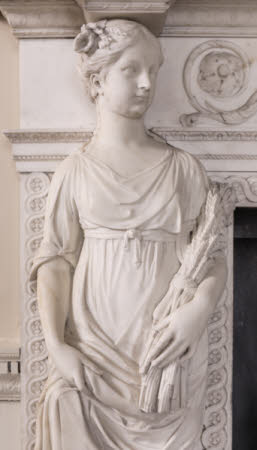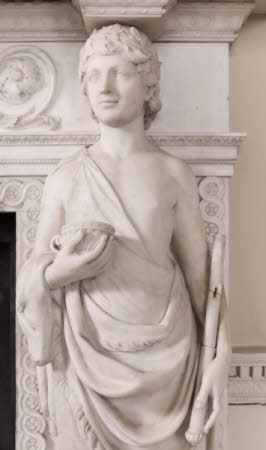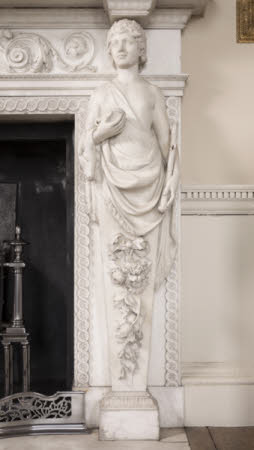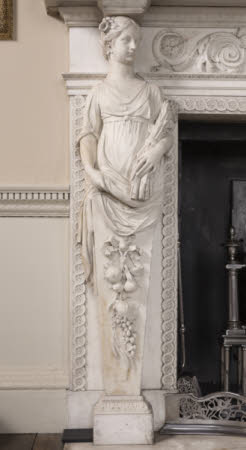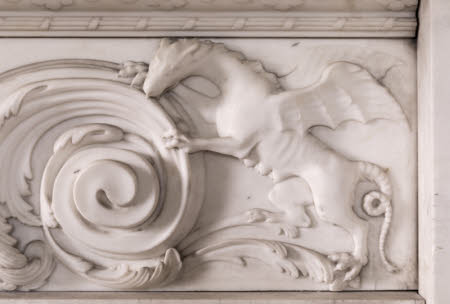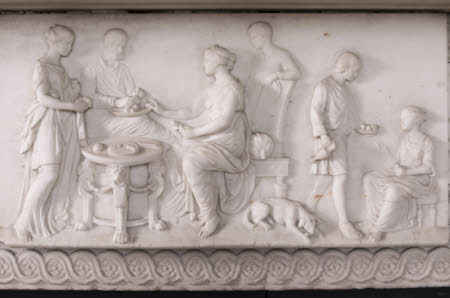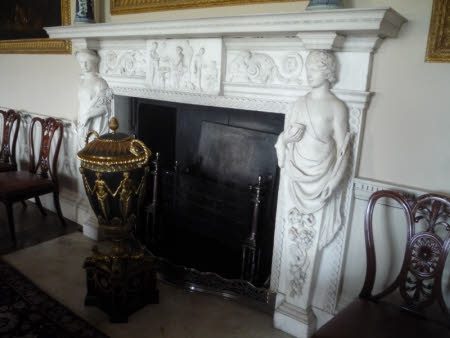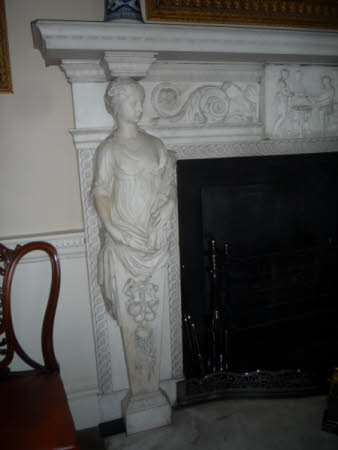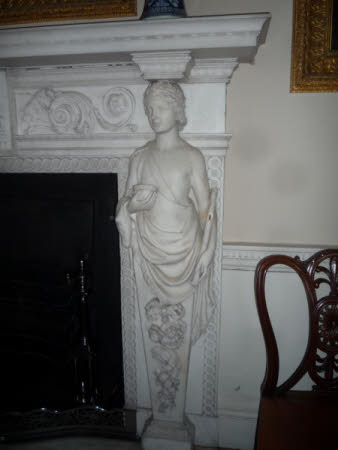The Dining Room chimneypiece
attributed to Michael Henry Spang (fl.c.1750 - d.London 1762)
Category
Architecture / Features & Decoration
Date
circa 1760 - 1765
Materials
Marble
Measurements
1670 x 2520 x 310 mm
Place of origin
Great Britain
Order this imageCollection
Kedleston Hall, Derbyshire
NT 107982.1
Summary
White marble, the Dining Room chimneypiece, attributed to Michael Henry Spang (d. 1762) after Robert Adam (1728-92) , c. 1760-65. A chimneypiece attributed to Michael Henry Spang, designed by Robert Adam (see NT 107982.1). In white marble with moulded rectangular shelf over frieze and centralized relief panel. The frieze is carved with scrolling acanthus supported to the left and right of the relief panel by a dragon and leopard respectively. The relief panel, after the antique, shows a Roman banqueting scene. At left a seated man and woman eat around a circular table with caryatid legs, lions' heads and paws. A young woman and young boy, perhaps servants, attend the couple. At right a dog chews on scraps on the floor and a male servant brings food and wine to a seated young woman. Two caryatid terms support the shelf: at left is Ceres, goddess of agriculture and fertility, holding a sheaf of wheat, at right is Bacchus, god of wine and revelry, holding a drinking cup and thyrsus (the top with pine cone has broken off). Fitting subjects for a dining room, Ceres and Bacchus are depicted again in medallions by William Collins installed in the west end of the room. The tapering pillars below the torsos of Ceres and Bacchus are carved with garlands of fruit, flowers, foliage and grain in high relief. With floriated cable motif framing the inner edges of the chimneypiece, repeated at the outer edge of the jambs framing caryatid terms. The Dining Room was completed in 1765 to designs by Robert Adam (see NT 109446). Adam's design for the chimneypiece is held at Sir John Soane's Museum within the Robert and James Adam office drawings collection (see SM Adam volume 22/16).
Full description
The sculptor Michael Henry Spang was a native of Denmark and was first recorded in England in 1758 after modeling a seal for the Royal Society of Arts. A receipt in the Kedleston Archive from James 'Athenian' Stuart (1713-88) marked 'London August 9 1758' shows that Spang was subcontracted by Stuart to carve four figures in wood (NT 108997) for the sum of £28 (around £2,800 in today's money). Spang was later commissioned to produce the Dining Room, Drawing Room and Music Room chimneypieces for Kedleston, for which he was paid £990 (see NT 107932, 107920). There are three designs by Spang for a ceiling, a bridge and a pavilion for Kedleston (NT 109248, 109249, 109499), a drawing of a mournful Sigismunda (NT 108920), and a miniature wax seal of the Scarsale coat of arms (NT 109110). Spang also acquired for Curzon a model of a British warship (NT 109114). Alice Rylance-Watson 2019
Provenance
Purchased by Nathaniel Curzon (1726-1804) c. 1760-64 as part of Robert Adam's remodeling of Kedleston; identifiable in 'Catalogue of the pictures, statues, &c. at Kedleston' (1769) as 'Chimney-piece. Statuary Marble. Terms of Bacchus and Ceres. Tablet, an ancient Repast' (p. 21); purchased with part of the contents of Kedleston with the aid of the National Heritage Memorial Fund in 1987 when the house and park were given to the National Trust by Francis Curzon, 3rd Viscount Scarsdale (1924-2000).
Credit line
Kedleston Hall, The Scarsdale Collection (acquired with the help of the National Heritage Memorial Fund and transferred to The National Trust in 1987)
Makers and roles
attributed to Michael Henry Spang (fl.c.1750 - d.London 1762), sculptor Robert Adam (Kirkcaldy 1728 - London 1792), architect Robert Adam (Kirkcaldy 1728 - London 1792), designer
References
Harris 1987: Leslie Harris and Gervase Jackson-Stops (ed.), Robert Adam and Kedleston: The Making of a Neo-Classical Masterpiece, London 1987

